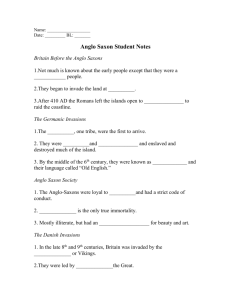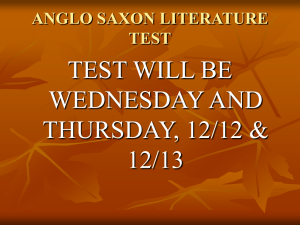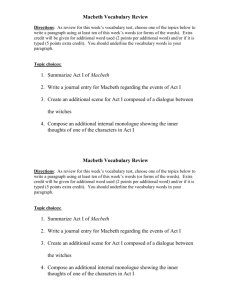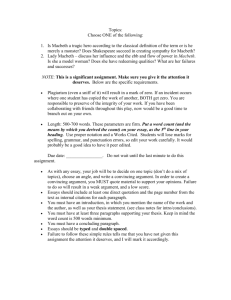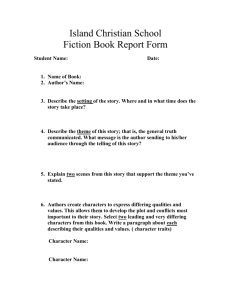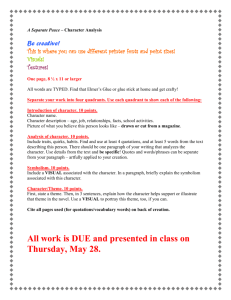Say It - Explain It
advertisement
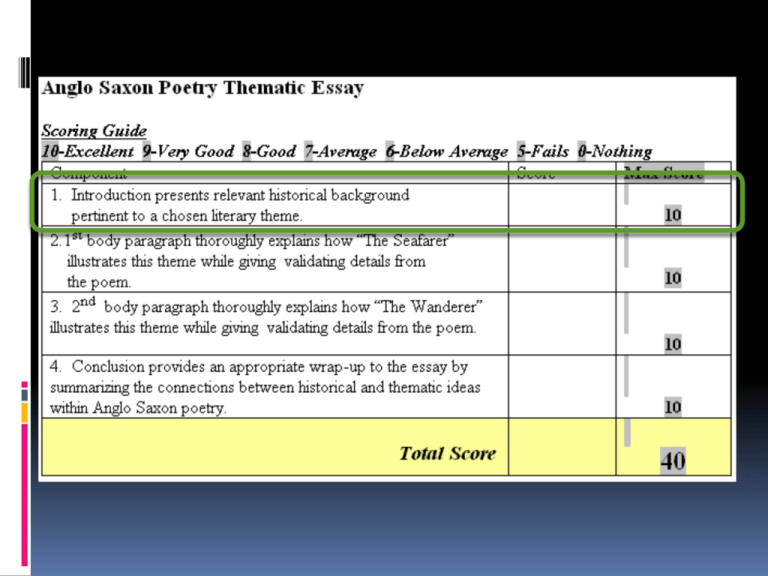
The Anglo Saxon time period was one of war. Also, Anglo Saxon people relied heavily upon their community. As a result, a theme of exile from one’s community is often found in the literature. Sounds like it might meet the rubric requirement; however, what is missing? • Specific historical connections to the chosen theme. • A logical connection between historical details and the chosen theme. The Anglo Saxon period in England was a time of conquest and upheaval. As a result, Anglo Saxon people relied heavily upon the protective structure within their community. Often times, the greatest conflict for an Anglo Saxon villager would be a separation and/or disconnection from that community. It is therefore no surprise that a theme of exile emerges from the literature of these Anglo Saxon people. • Now there is a logical connection between historical details (conquest, upheaval, and the need for community) and the chosen theme (exile). This theme of exile is found in The Wanderer. Here, a man is exiled from his village because everyone has died, and he no longer has a lord to lead him. He, therefore, wanders the sea in search of a new lord and a new community to call home. Again, seems like it might meet the rubric requirement; however, what is missing? • Thorough explanation • Specific validating quotes and line numbers to prove ideas are correct. This theme of exile is found in “The Wanderer.” Line nine of the poem paints a picture of a man who is exiled from his village because everyone has died, and he no longer has a lord to lead him: “Lonely and wretched I wailed my woe. No man living, no comrade left.” His exile is emphasized through the imagery of his grief in line forty three when the speaker declares, “bitterer then is the bane of his wretchedness, the longing for loved one: his grief is renewed.” . . . . . . . . •Now there is a clear focus and a clear explanation. •Also, there are validating quotes (with line numbers) to substantiate the idea that the poem, “The Wanderer” is a good illustration of the them of exile. Say It Explain It Validate It A WRITING MODEL Say It . . . In a paragraph The first goal of any piece of writing: State your message (Say It) Example: Many paragraphs are built around a topic sentence, a single sentence that directly states the paragraph’s main idea. The other sentences support, explain, or illustrate the topic sentence. The topic sentence STATES your idea. Say It . . . In a paragraph To write an effective topic sentence, analyze the group of details and ideas that you plan to include in a paragraph, and come up with a statement that sums up the common features of the details and ideas. For example, if you were writing a paragraph about the number of careers involved with working on the Internet, you might write the topic sentence below. SAMPLE TOPIC SENTENCE: There are a wide range of possible careers related to the Internet. You just STATED your point. Say It . . . In a composition This also applies to writing essays and compositions. The first paragraph, the introduction, focuses your reader on a particular topic. Here, in the introduction, you STATE (say) your main idea for the entire essay. Thesis statement Say It . . . In a composition A thesis STATES (SAYS)the key point or argument you wish to make about your topic. To create a thesis statement, read your grouped notes carefully. Decide on the most important ideas you have gathered, and summarize them. Sample Thesis Statements: The space program of the 1960’s helped to unite Americans. The childhood of Queen Elizabeth I of England had a great impact on decisions she made as a ruler. Explain It . . . In paragraphs Your topic sentence contains the paragraph’s main idea and guides the rest of that paragraph. The remaining sentences in the paragraph should develop, EXPLAIN, or illustrate the topic sentence. These are called supporting sentences. Explain It …… In compositions Your BODY paragraphs provide all the EXPLAINING needed to break-down your thesis into understandable parts. A great tool for organizing the elaboration and explanation found in your body paragraphs is the use of an outline. Validate It . . In all writing Validating something is equal to Proving it to be true, accurate, worthwhile, etc… It is simply not enough to state you point and explain it . . . . You need to VALIDATE (prove) its worth. Validate It . . In all writing Validation comes from citing outside sources that prove your points and your explanation to be true or worthwhile. When writing about literature, validation will come from: The text we are studying Literary criticism Other outside research Say it–Explain it–Validate it example Macbeth’s true self acknowledges that killing Duncan will Here you are stating (SAY it) serve no good purpose. you main point clearly and directly Say it–Explain it–Validate it example While alone, Macbeth decides he will not kill Duncan because it would be disloyal and eventually damn his Here you are explaining your eternal soul to hell point specifically as it SHOWS how he is not listening to his moral conscious. Say it–Explain it–Validate it example In Act 1, scene 7 Macbeth laments, “But in these cases We still have judgment here, that we but teach Bloody instructions, which, being taught, return To plague th' inventor: this even-handed justice Commends the ingredients of our poisoned chalice To our own lips.” He realizes his actions will have eternal consequences. Here you are VALIDATING your ideas with support from the text. This proves your ideas to be true and worthy. Say it–Explain it–Validate it example Macbeth’s true self acknowledges that killing Duncan will serve no good purpose. Part of Macbeth’s problem is that he will not listen to his moral conscience. While alone, Macbeth decides he will not kill Duncan because it would be disloyal and eventually damn his eternal soul to hell. In Act 1, scene 7 Macbeth laments, “But in these cases / We still have judgment here, that we but teach / Bloody instructions, which, being taught, return / To plague th' inventor: this even-handed justice / Commends the ingredients of our poisoned chalice / To our own lips.” He realizes his actions will have eternal consequences.
